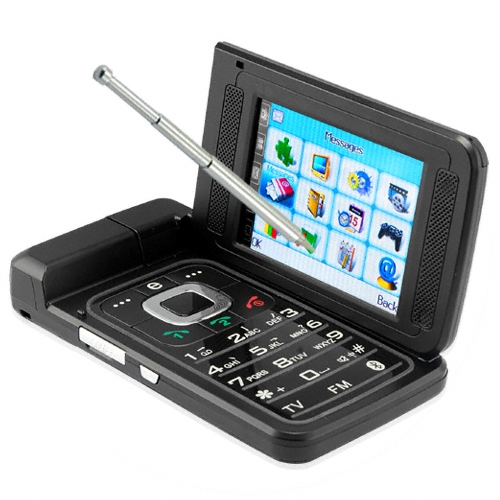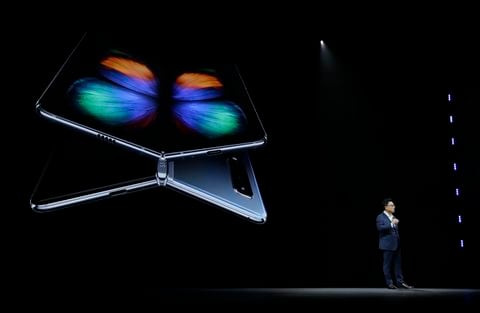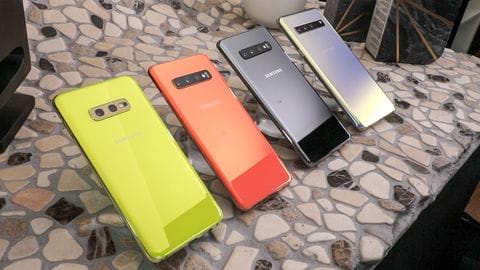Pomidor Quixote
Daily Stormer
February 21, 2019
Welcome to the $2k smartphone era. Samsung’s Galaxy Fold is coming in April for $1980. #SamsungEvent pic.twitter.com/bJoUaui70n
— Geoffrey A. Fowler (@geoffreyfowler) February 20, 2019
It finally happened! The Koreans finally did it.
Smartphones are no longer rehashes of previous models. Current year smartphones are no longer pretty much the same as last year’s.
Customers are no longer going to be paying for the same thing with a different build aesthetic.
The next smartphone revolution is here.
AP:
Samsung unveiled a highly anticipated smartphone with a foldable screen in an attempt to break the innovation funk that has beset the smartphone market.
But it’s far from clear that consumers will embrace a device that retails for almost $2,000, or that it will provide the creative catalyst the smartphone market needs.
The Galaxy Fold, announced Wednesday in San Francisco, will sell for $1,980 when it is released April 26.
Consumers willing to pay that hefty price will get a device that can unfold like a wallet. It can work like a traditional smartphone with a 4.6 inch screen or morph into something more like a mini-tablet with a 7.3 inch screen.
NOW PHONES CAN FOLD!!!
THIS IS 2006 NOW BABY FUCK YEAH BEHOLD THE REVOLUTION!!
Err… wrong picture.
This is the Samsung Galaxy Fold:
Welcome to the future.
When fully unfolded, the device will be able to simultaneously run three different apps on the screen. The Galaxy Fold will also boast six cameras: three in the back, two on the inside and one on the front.
After spending nearly five years developing the technology underlying its foldable-screen phone, Samsung is clearly hoping for a big payoff.
“Get ready for the dawn of a new era,” declared DJ Koh, who oversees Samsung’s smartphone division. The new phone, he said, “answers skeptics who said everything has already been done.”
If Samsung is right, the Galaxy Fold will spur more people to upgrade their phones. Overall smartphones sales peaked in 2017 ; Samsung saw its smartphone sales fall 8 percent last year, based on estimates from the research firm International Data Corp. Worldwide, smartphone sales dropped 4 percent in 2018, according to IDC.
Give at least a couple of seconds to the thought of Samsung spending five years and who knows how much money to develop something that has no real pragmatic benefit. Do you see how rotten the smartphone business is?
Samsung also released new Galaxy S10 phones that echo the features in other recent models. Each device in the S10 lineup boast fancy cameras, sleek screens covering the entire front of the devices and at least 128 gigabytes of storage — important features to consumers shopping for phones.
Samsung Galaxy S10
The new phones are able take wider-angle shots than previous models and can charge other devices, including wireless headphones and smartwatches. A fourth S10 model, due out this spring, will have faster wireless speeds through the emerging 5G cellular network.
Huawei was already doing that with their 2018 phones.
Samsung is offering a slightly smaller S10 model for $750 in an attempt to make smartphones more affordable, but the higher-end models sell for $900 and $1,000. It’s the second time in the past five months that a leading smartphone maker has positioned a $750 phone as a frugal option. Apple also priced its cheapest new phone, the iPhone XR, released last fall at $750. Other smartphone makers gaining market share, including China’s Huawei and Xiaomi, make smartphones that sell for $500 or less, as well as high-end models.
Two of Samsung’s new models, the S10 and the S10 Plus, are largely incremental upgrades of last year’s S9 and S9 Plus, although they are designed differently. They are about the same size as last year’s models, but will have more display space, as Samsung found additional ways to eliminate waste around the edges. As a byproduct, the top right of the display has a circle or oval cut out for the front-facing cameras.
The lowest-priced “essentials” model, the S10e, has most of the same features, but is 5 percent smaller than the S10 in volume. The S10e also lacks curved edges, a signature feature for many Samsung phones.
All three S10 models will come out March 8, with pre-orders starting Thursday.
As you can see, this year’s smartphones are going to be pretty much the same as last year’s… like it happened last year.
Here are the main differences in 2019 Samsung flagships compared to last year’s:
- Front camera is now a tiny hole in the screen, allowing for bigger screens in phones similar in size to last year’s
- They now have more cameras
- Bigger battery capacity
- There are different versions of the flagship with different prices
- One of their flagships can fold
- The fingerprint sensor is in the front now, inside the screen
- They are more expensive
- Samsung is going for a “status symbol” thing
- More RAM
- More storage
The bigger battery is obviously welcomed, but the biggest one they appear to be going to use is 4,500 mAh which is nothing revolutionary. Huawei flagships were already sporting 4,000 mAh years ago. They’re likely going to put the 4,500 mAh battery in the Galaxy Fold, their most expensive model.
The battery won’t last longer, because the phone is more resource intensive.
Samsung Galaxy S10 colors.
More cameras… whatever. Some will appreciate the wide-angle thing.
The fingerprint reader being on the front right under the screen is a nice change, yes, I mean… all of these are more or less nice changes, but why should anyone pay for that if they already have a Samsung S9 or S8?
Fingerprint reader of the Samsung Galaxy S10.
But wait.
Do you like bricks?
Because the Galaxy Fold looks and feels like a brick.
Skip to 3:38 to see it in action.
Pretty thick, huh? As you can see, it’s going to cost $2,000 because it’s practically two phones joined together with an additional folding screen slapped in their backs.
But it’s a status symbol.
It makes a statement.
The trend so far was to just add more cameras, but Samsung kicked it up a notch and now they’re adding more screens too.
So… what do you say?
Do you want your phone to have more cameras and more screens?
…and to cost $2,000?
 Daily Stormer The Most Censored Publication in History
Daily Stormer The Most Censored Publication in History









